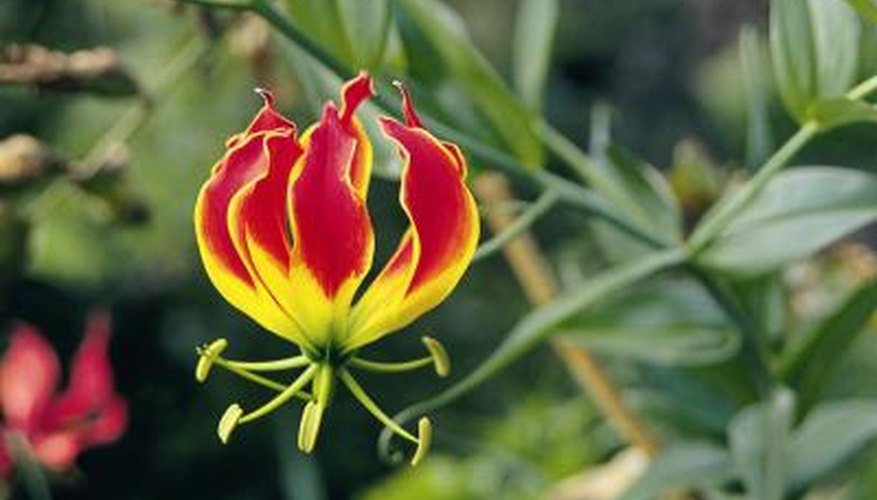Flame lily, also known as the Gloriosa lily, is the national flower of Zimbabwe, where it grows in abundance. These plants, which produce large, bright yellow and red flowers, have developed several adaptations which allow them to thrive in the harsh environment of the African savannah. Not only are these plants hardy, but they are also quite lovely, with ruffled petals that sweep up, making the plant fascinating for a number of reasons.
Toxicity
The flame lily is a highly toxic plant. All parts of the plant, including roots, stem, leaves, and flowers, are toxic when swallowed. Touching the roots or tuber of the plant can also cause skin irritations. Symptoms of flame lily poisoning develop within two to six hours, and the poison can be deadly. This toxicity is due to a chemical within the plant called colchicines. This lethal adaptations ensures that animals that attempt to make a meal of the flame lily don't come back for a second try. The bright colours of the flower also warn predators of its toxic nature, ensuring that the plant remains relatively safe.
- The flame lily is a highly toxic plant.
- The bright colours of the flower also warn predators of its toxic nature, ensuring that the plant remains relatively safe.
Climbing Ability
Flame lilies are climbing plants. They climb toward the sun, so as to better absorb the light they need to create nutrients through photosynthesis. Flame lilies can grow to an impressive height of 8 feet tall. This climbing ability also gives the flame lily an advantage over shorter plants. Not only does the climbing itself serve as an adaptation, but the flame lily has developed sensitive tendrils which curl around other plants. Thus, the flame lily can use its neighbours to boost and strengthen it.
- Flame lilies are climbing plants.
- This climbing ability also gives the flame lily an advantage over shorter plants.
Drought Survival
Flame lilies grow and bloom during the wet season, since the growing plant requires a lot of water. However, during other parts of the year, the plant has developed a drought-survival adaptation. Each year, the plant develops from a tuber, which sprouts underground. This tuber is extremely drought-resistant, and can therefore stand the arid conditions of the savannah during the dry months.
- Flame lilies grow and bloom during the wet season, since the growing plant requires a lot of water.
- However, during other parts of the year, the plant has developed a drought-survival adaptation.
Pollination
Although flame lilies can self-pollinate, they have adapted their shape to achieve cross-pollination, which can give future flame lily generations a more diverse genetic background. Flame lilies grow their stamens and pistils from the bottom of the flowers. The pistil area is located at the base of the flower, while the stamens stretch out, far from the pistil. This shape avoids self-pollination, as the two reproductive organs cannot touch, and promotes easy cross pollination.
- Although flame lilies can self-pollinate, they have adapted their shape to achieve cross-pollination, which can give future flame lily generations a more diverse genetic background.
